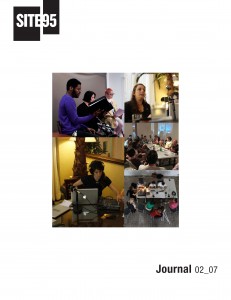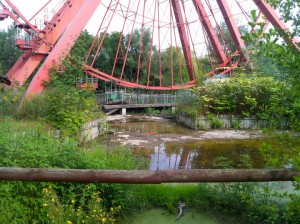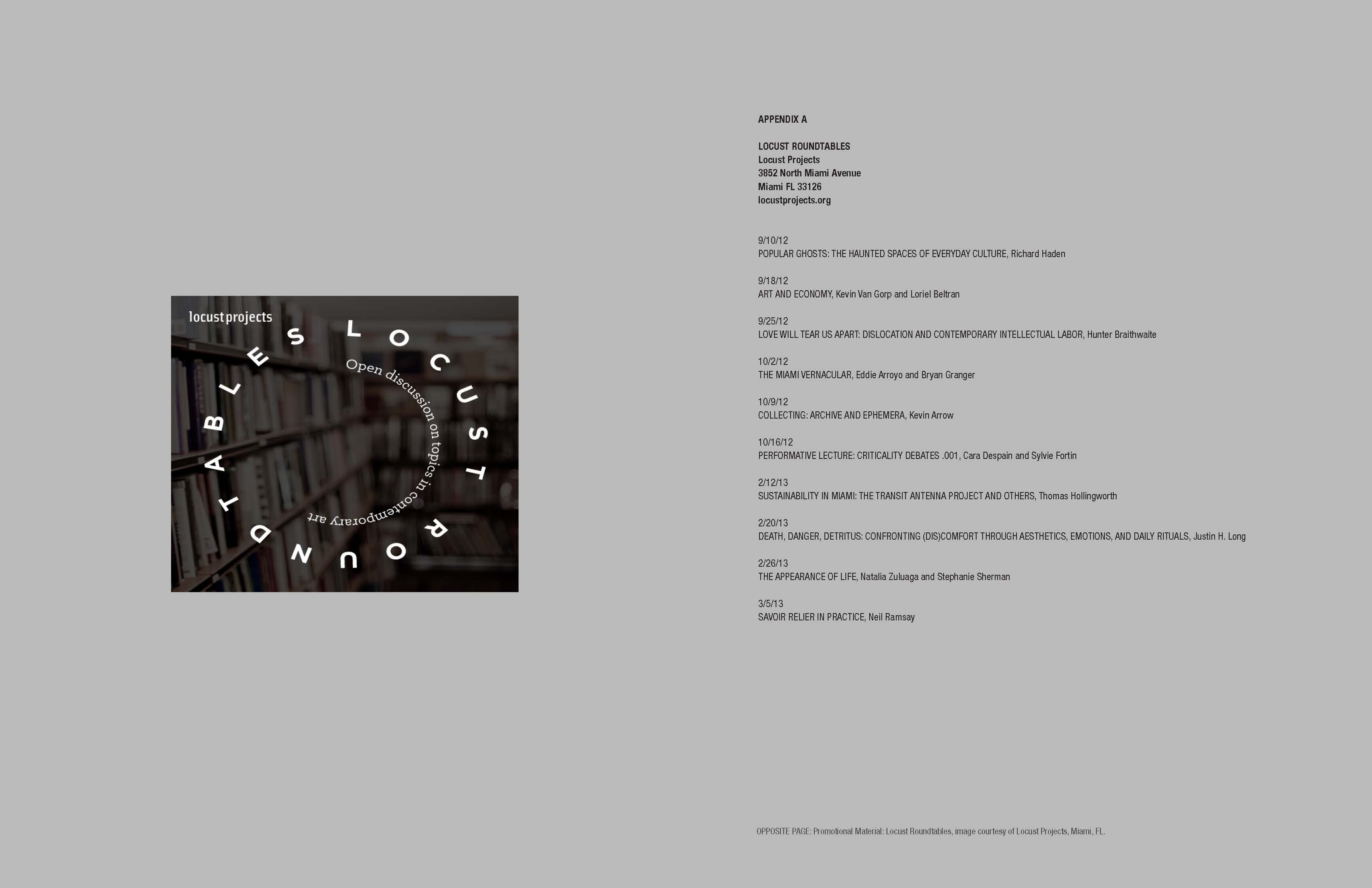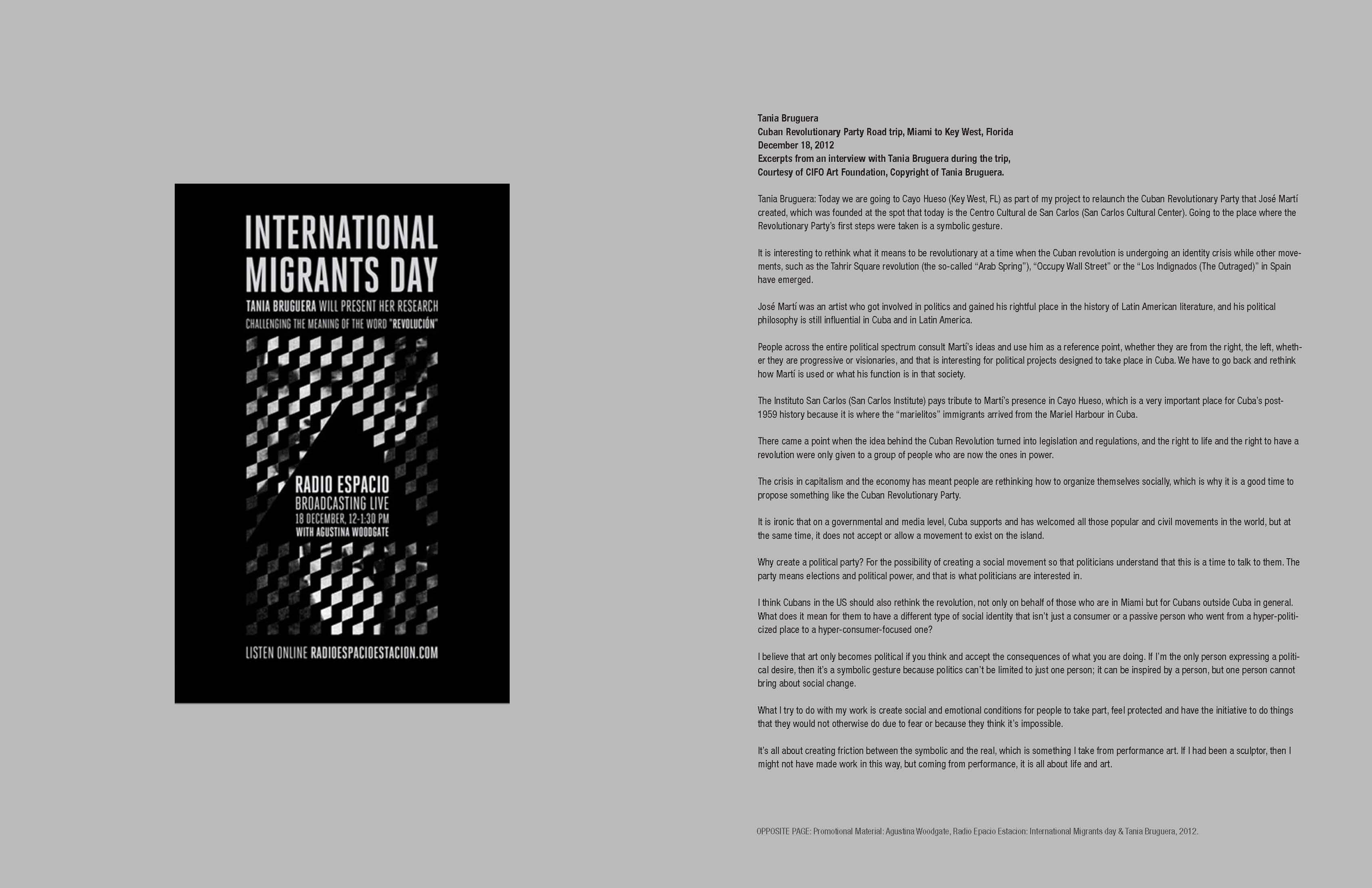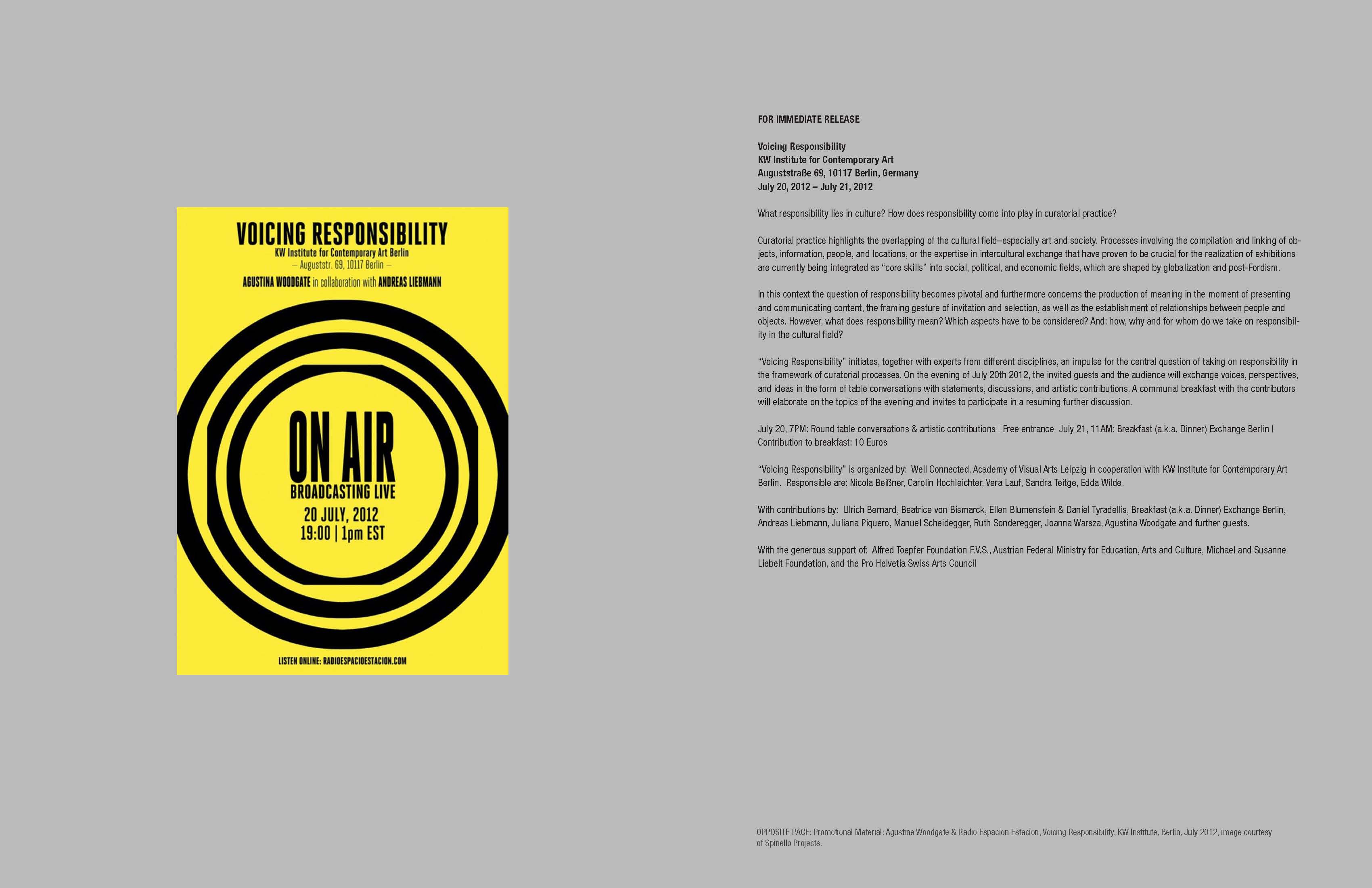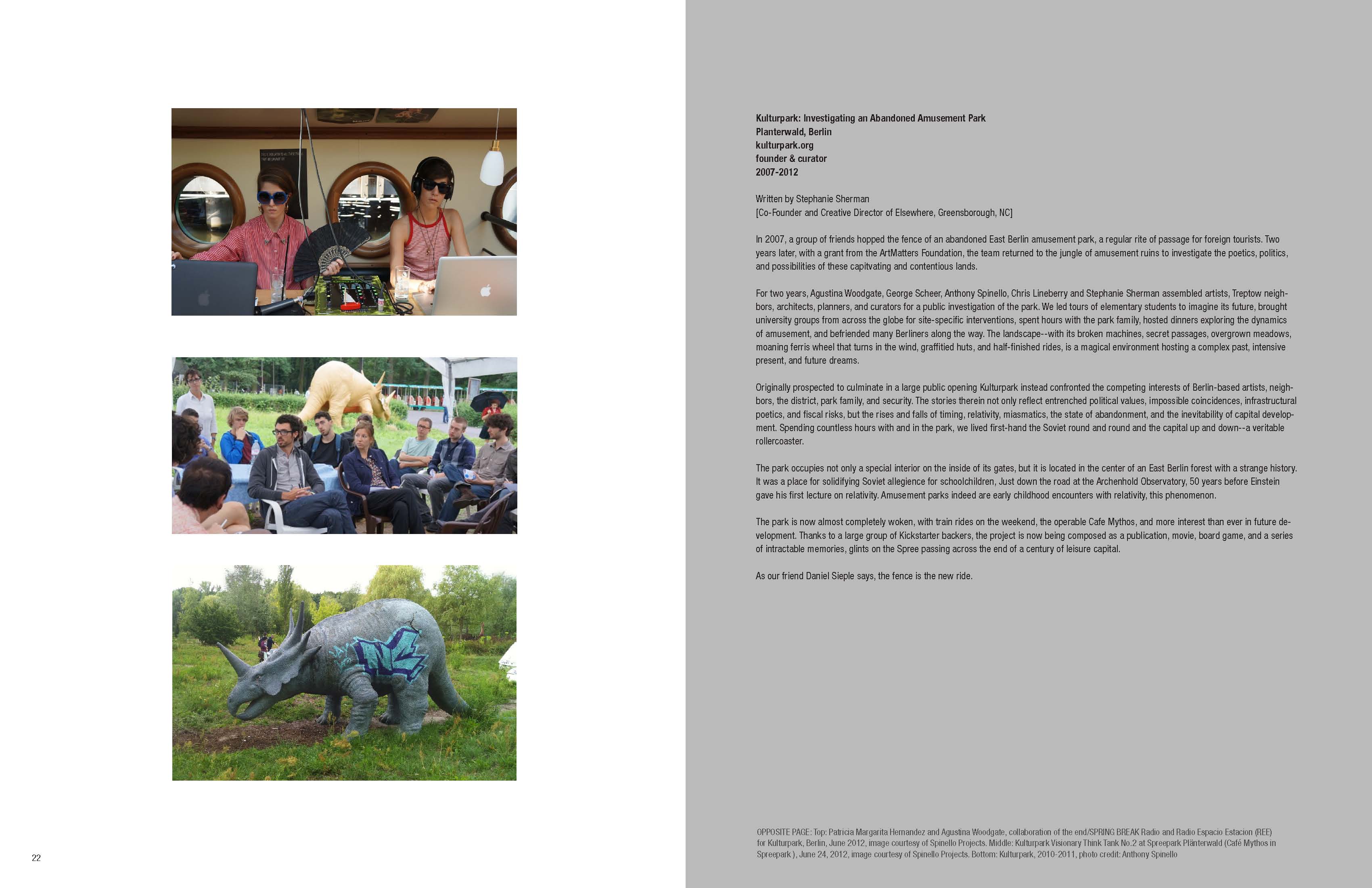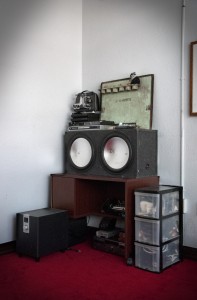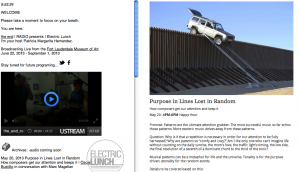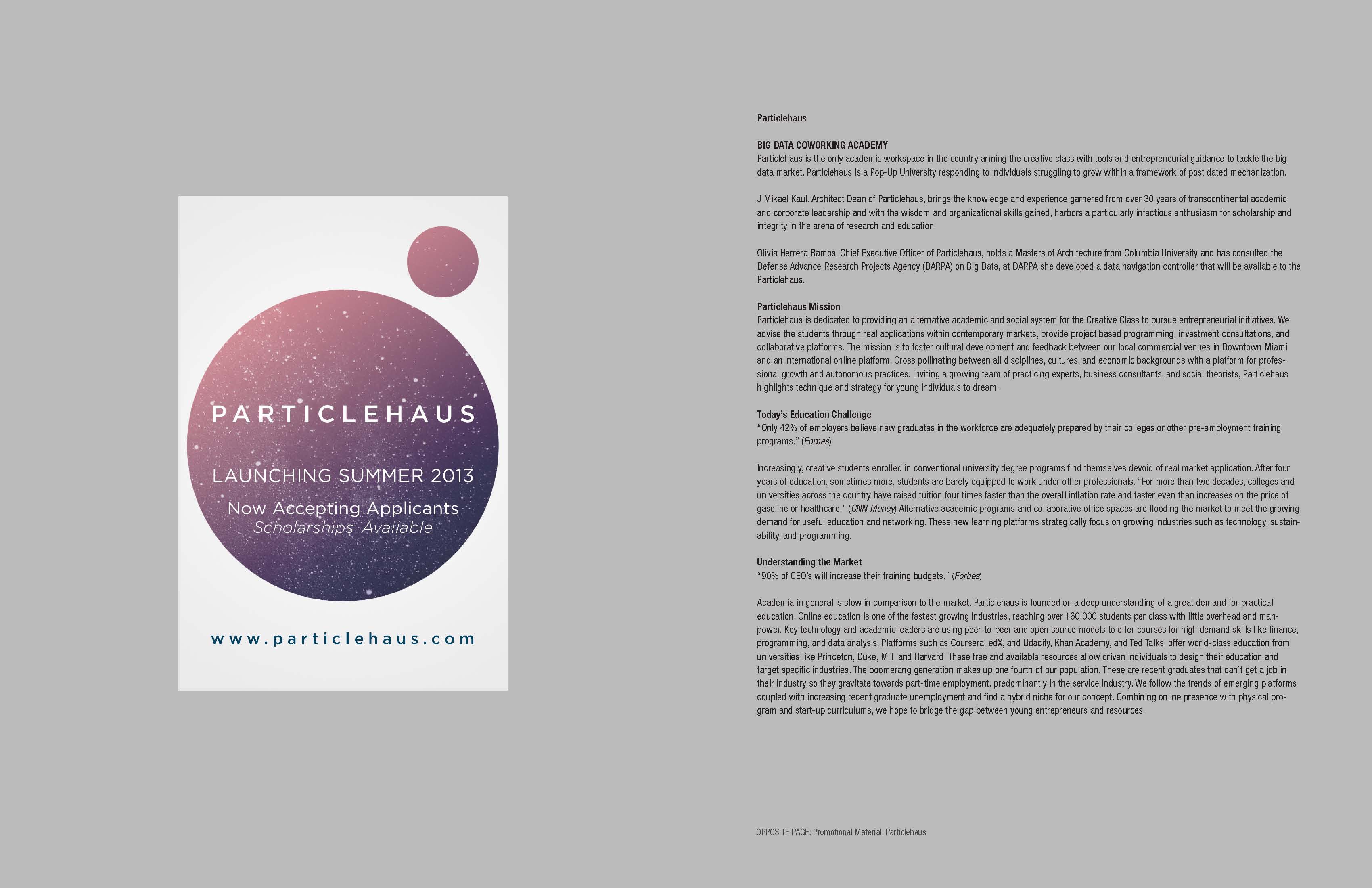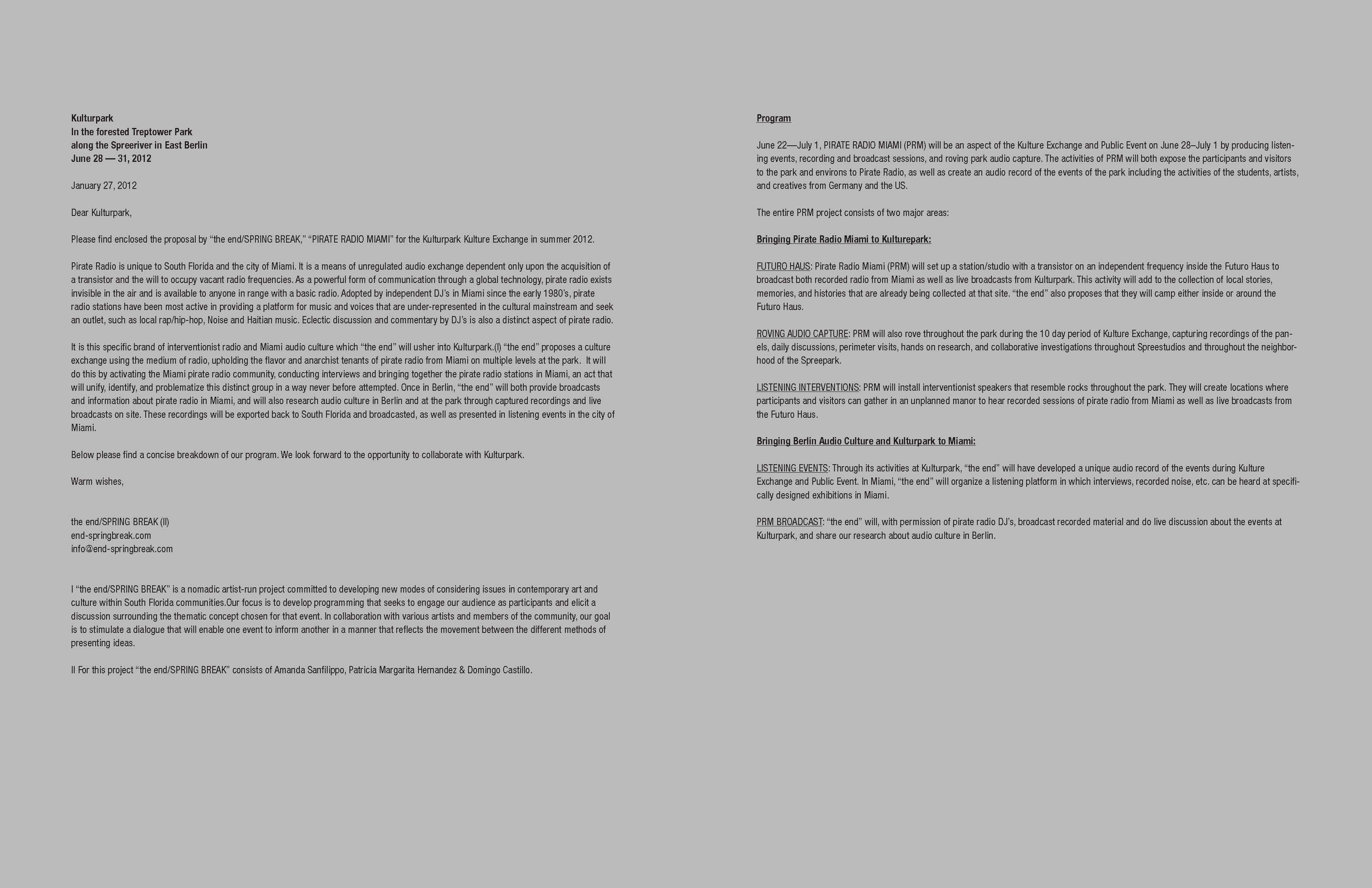02 07
02 07
DOWNLOAD PDF: site95_Journal_02_07.e
Editor in Chief Meaghan Kent, Contributing Editor Janet Kim, Copy Editor Beth Maycumber, Copy Editor Jennifer Soosaar, Copy Writer Kati Henderson
Curated by Amanda Sanfilippo
Featuring: Agustina Woodgate, Olivia Ramos, Patricia Margarita Hernandez
Journal designed by SITE, Logo designed by Fulano
Special thanks to The Cisneros Fontanals Art Foundation
Alternative Education on the Radio: In Miami and Beyond by Amanda Sanfilippo
For the past 15 months, I have been engaged in organizing discursive structures, specifically programming and moderating open format discussions on topics in contemporary art. The sessions were fed by my own earnest interest in the subject matter and inclination towards open discussion over the more didactic structure of a lecture or panel. Folding in different voices like cake batter, the arc of the conversation was shaped through integrative moderating and spats of disagreement. In an eight-week series called Miami Curator’s Symposia,(I) the first iteration of these talking experiments took place in downtown Miami at the non-profit organization Cannonball (Formerly Legalart). Presenting only the name of the topic in advance, I would often initiate each session by briefly presenting my own research, questions, and presuppositions. In the absence of assigned reading, I asked participants to bring their own research and material–literally books and relevant texts and references. Because of these factors, and also because some topics were original, “Dumb Art” stands out, in particular, more often than not the entire discussion period was spent hacking away at what the topic actually was, and if it was indeed anything at all.
Aided by the weekly consistency of the events, what quickly became an unspoken principle/ideal of the relatively short and lively sessions was an imperative to move swiftly with ideas. Participants were encouraged to describe an artist, practice, exhibition, theory, or concept, agree/disagree with one another, and support with examples, allowing the conversation to contribute to the shape of the topic. The sessions began to reward more antagonistic tendencies and discourage opinion-based comments, in favor of a discourse that flowed with facts. Adhering to a strict time schedule, the frank discussions often raced to the last moment, when I promptly silenced them like a smug judge. And, as was one of my favorite things about being a graduate student in London, everyone was encouraged to continue by descending en masse upon the nearest bar, in our case, an establishment called “The Corner” at the intersection of North Miami Avenue and Eleventh Street. Spilling out onto the sidewalk in the effervescence of deliberate talking, the conversations fractured and deepened, sometimes early into the morning. And perhaps most satisfying to me was how the whole environment created a feeling of anticipation, that through this open vetting, some particle of knowledge would be shared/produced. The sessions also generated heavy sighs, disappointment, frustration, elitism, naïveté, pre-conceived notions, and awkward clashes of experience and perspectives. While easy targets for intellectual dumbing-down, at worst an “entertainment machine celebrating critique-lite,”(II) the sessions were made sharp and critical in only one way: worthwhile contributions from participants presenting what was at stake or offering relevant information. Each talk was an implicit challenge and at moments, they soared. The best sessions resolved in a universality of terms and ideas, where a gradual group-teaching emerged. I began to think of them as foot-findings where sophisticated ideas could be addressed, but also where those who attended largely came out on the same page. I myself was motivated to learn, not teach.
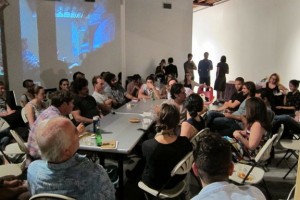
Locust Roundtables: “The Miami Vernacular,” October 2, 2012, image courtesy of Locust Projects, Miami, FL.
Several months later, this ‘ignorant schoolmaster’(III) style-format transformed into another series of discussions at Locust Projects (which I have been associated with since 2011), known now as the “Locust Roundtables.” This time inviting members from the Miami art community and passers-through to generate topics and moderate as they saw fit, these talks began to take on more mutable formats: as performative lectures, incorporating slides, debates, spirit readings, et cetera. In keeping with the mission of the alternative non-profit which hosts them, the topics and formats themselves were experimental. They were ideas that the presenters were working out themselves for the first time, such as Hunter Braithwaite’s “LOVE WILL TEAR US APART: DISLOCATION AND CONTEMPORARY INTELLECTUAL LABOR.” Yet the keystone of the gatherings, whether intimate and heady or ballooning out into unruly escapades, such as the evening featuring the “Miami Vernacular,” remained the imperative for an open format, the challenge to articulate and defend a position. To date, we have completed ten sessions; the next series of five is planned for August and September 2013.(IV)
Other than being a topic dear to my heart, all this is to say that the drive to participate in such discussions and the pervasiveness of conversation platforms in relatively recent contemporary art activities has been of particular interest to me and others in the field for some time now. It is a handful of these discursive platforms/alternative education models which I will sketch, with interest and homage to the work of several contemporary art historians and academics whose work sheds much light on the role of this talking. These sets of ideas, combined with the activities of several artists based in Miami and notable projects and initiatives which have taken place here and in relation to the bottom of the 95 corridor, are what binds the following pages of this journal together.
***
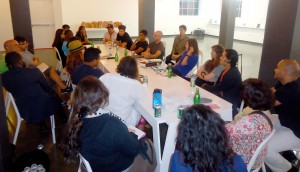
Miami Curator’s Symposium, May–June 2012, hosted by Cannonball (Formerly LegalArt, Miami, FL, image courtesy of Amanda Sanfilippo.
More than just an interesting and self-affirming thing to do, the habit of talking in and among contemporary art contexts is complicated, sliding apart into a few distinct discs that overlap in fascinating and generative ways. It has been argued that the emphasis on dialogue in and around contemporary art is the most significant shift in the last decade or so,(V) distinguishing a generation of artists and related activity in the field. Described as ‘new institutionalism,’(VI) art historians such as UK-based Claire Doherty highlight significant increases in how institutions and art events of all kinds are operating as open-ended platforms, and how this necessarily generates dialogue in close relation to programming, or literally as programming. At its core a re-visioning of the role of institutions, this term crystallized around 2006 and has mostly been generated by European cultural sites in curatorial discourses.
Another disc which slides from this dialogue is the educational turn, and indeed, the whole concept of turning–which is to say, trending towards certain kinds of formats and practices, and in this case, art turning to education. Emerging around 2010 and owing to a wide swath of practitioners, London-based art historian and teacher Irit Rogoff is a central figure with a history of pertinent scholarship and participation in related events. The so-called educational turn relates to new institutionalism, yet concentrates more on the ways in which discursive, open-ended programming provided by contemporary art institutions can function as alternative education and research sites. Furthermore, practicing unaccredited education in and among art gatherings with topics and expertise outside of the art world fosters a cross-disciplinary experimental zone where participants can “attend to the production and articulation of truths…” as opposed to re-enforcing objective knowledge.(VII)
Highlighting the centrality and emergence of alternative education structures, the educational turn also contextualizes such artist, curator, and institution-initiated temporary schools, project spaces with class-like programming, temporary initiatives at museums and institutions, artist-directed academies and initiatives of which are amply described,(VIII) and artists working or acting as self-appointed institutions. With this strong emphasis on talking, more often than not the formation of such educational platforms takes precedence over any substantive evaluation of what is being discussed.
In relation to both these aspects is the identification of an art practice, socially and politically motivated (by neo-liberalism and the monetization of education), that is definitively post-medium and post-studio. It is in this environment of art making, long after the introduction of the ready-made and the imperative to learn a set of skills to best reproduce tradition, that the ‘deskilling’ and ‘deschooling’ of contemporary practitioners thrives. This set of ideas is presented and elaborated upon by Vivian Sky Rehberg, an art historian and critic based in Paris.(IX) She addresses artists as “generalists,” rather than “specialists,” in any medium. Rehberg also points to the potential of carrying conversations across various disciplines, and to the development of a ‘speculative mode’, where it is possible to invent subjects and explore margins and cross-overs in an academic manner, but without the limitations of academic institutions.
Rehberg’s idea adds to the discussion regarding the codification of and dialogue around the term ‘knowledge production’. While tossed around like a wave, the term is probably best defined by European-based writer/curator Simon Sheikh as a “commodification of knowledge”, and further elaborated on by Hal Foster, American art critic and historian, as a “promiscuity of collaborations,” pinpointing a shift to “literal space” where the focus is no longer on the production of objects but instead on the production of space where things happen.(X) Simultaneously widely misinterpreted and still in the process of becoming understood, the notion of producing knowledge in contemporary art today is as deeply rooted in both art practice as curatorial practice, and twins with the wider terms of ‘educational turn,’ and ‘new institutionalism,’ all of which are seeking/producing some kind of knowledge/truths. For my purposes and to circle back to the Miami Curator’s Symposium and “Locust Roundtables,” I would like to position the following more in terms of positive aspiration/will and to consider that, as Irit Rogoff ended her essay “Turning”: “truth is not a position, it is a drive.”(XI)
***
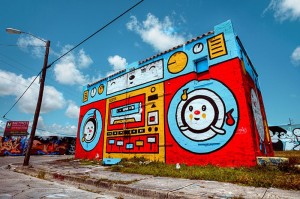
Sonni, Miami Boom Box (applied titled), public mural, estimated duration 2009-2011. Project courtesy of Primary Flight, Miami, FL.
Because Internet radio is streamed on any host page with basic web technology, all online radio is essentially pirate radio, in that it is not regulated. A format beloved in the magic city, pirate radio has a long and rich history in Miami and has become adopted by contemporary art practitioners everywhere possible in recent years.(XII) Such programs take on a professional air of organization, with schedules, archives, streaming and podcasting capabilities. As an enabler of space, place and individual voices, the mobilization of live Internet radio, and event-based radio in particular, is an interesting, unfettered zone of expression and information, creating a new form of which there is no shape. Continuing the dematerialization of the art object, art practices embracing radio today operate as nearly pure information streams, further excused from producing objects as catalysts for ideas or representations. And yet, while as an art practice such actions can be viewed as performative, site-specific, time-specific, situation-specific, as happenings, et cetera, online radio is also just that: online radio. The medium specificity of online radio–a provider of widespread access to audio content, from music, to talk, to sounds, to documentation- plays an important role in the production, dissemination and reception of such projects. A notable project utilizing more of a sound-as-medium…?
As a result of the proximity of working closely within an art community, I am pleased to offer several primary documents and excerpts from a handful of projects, all loosely connected through the electronic transmission of live Internet radio. Moreover, it has been a delight to find and sometimes become co-opted into some of the developments present here. Through a process of learning the connections between projects, it became clear to me that the important part of their linkages had more do with talking than it had to do with the radio, and that it actually had to do more with alternative education than with talking in the modes described above. This lean to education structures on the radio seems a natural fit, an inspiring example being one realized this summer in a large-scale project by Thomas Hirschhorn: “The Gramsci Monument,” made possible through the Dia Art Foundation. To touch on this lightly, an aspect of the project entails a live Internet radio station broadcasting from Forest Houses, Bronx, New York. The radio program includes the staples of a daily lecture, a newspaper, and an ambassador’s note, among a variety of other programming.
***
MIAMI ON THE RADIO
For the purposes of tracing the lines between noted projects and the exploration of their mutable forms, I will briefly state facts, details of which are elaborated upon in the following transcriptions and excerpts. Given the specific history of analog pirate radio in Miami, broadcasting as an art practice started most clearly with Agustina Woodgate and the formation of the bilingual English/Spanish “Radio Espacio Estacion (REE)” in 2010-2011.(XIII) The first instatement, which took place in October of 2011 at the Elsewhere Museum in Greensboro, North Carolina, was an experiment in site-specific radio programming, in language, and in bilingualism. Henceforth, Woodgate has broadcasted the online station nomadically, though the greatest listening base remains in Miami and Argentina.
The next iteration of “REE” was at Kulturpark, a large-scale collaborative exhibition executed by Woodgate and Miami gallerist Anthony Spinello. Taking place in Planterwald, Treptower, Berlin, from June 28 2012—July 1, 2012, Kulturpark was a multi-disciplinary gathering of projects spanning art, education and cultural spheres based around the activation of an abandoned amusement park. There, Patricia (Patty) Margarita Hernandez collaborated with Woodgate to build an audio exchange platform in the spirit of Miami’s unregulated pirate radio culture for “the end/SPRING BREAK,” a collaborative project Hernandez co-founded and co-operates with Miami-based artist Domingo Castillo. For this iteration, the radio station was set up at the perimeter of the park, and incorporated both music and conversation. Furthering the development of temporal, event-based radio, the project also served as a record of Kulturpark and a formalized exchange with Miami-based artists and listening audiences.
Woodgate activated “REE” once more in Berlin later that summer, as an integral part of the exhibition “Voicing Responsibility.” hosted by the KW Institute for Contemporary Art, July 20–21, 2012. Emphasizing the value of dialogue and listening, the exhibition was composed of eight dialogue tables throughout the galleries, each led by a keynote speaker. The transcriptions of the exchanges were recorded and broadcasted. Recognizing language/communication as a medium came to bear as the conversation fractured from bilingual to trilingual, and the radio event became both site and sound specific. Wynwood has performed “REE” in a number of other venues and also in collaboration with the mostly music online station, Wynwood Radio, at the Art Live Fair, October 2012.
At the tail end of 2012, “Radio Espacio Estacion (REE)” became a platform for internationally-renowned artist Tania Bruguera (Cuba), for the 2011 Grants & Commissions Program of the Miami-based Cisneros Fontanels Art Foundation (CIFO). Woodgate was asked to join forces with CIFO to broadcast a performance by Brugera granted by the commission, which took place at the San Carlos Institute in Key West, Florida, on December 18, 2012, International Migrants Day. Using the radio platform to give a press conference, Tania Bruguera reopened the Partido Revolucionario Cubano, in the same place where Jose Marti wrote his first draft for the foundation of the Partido Revolucionario 1892. The press conference was conducted entirely in Spanish to a handful of witnesses. CIFO subsequently produced a short video documenting the performance and road trip. The piece was enacted on the heels of Bruguera’s project, “Immigrant Movement International (IMA),” produced by the Queens Museum of Art and Creative Time. That project had its first instatement in Corona, Queens, in 2011, and is intended to move to other specified locations throughout the world in a five-year durational project. The activities of “IMA” are focused around building a community resource center addressing the needs of immigrants and towards developing a sense of identity for immigrants as a group of unique global citizens with distinct experiences.
The flexibility of “REE” is also evident in the evolution of Hernandez’s subsequent development of “the end/SPRING BREAK Radio,” originally conceived for Kulturpark. This new facet of “the end/SPRING BREAK” continued to produce event-based radio in a nomadic capacity throughout 2012 and early 2013. During this time period, Hernandez independently formulated a new online radio program, “Electric Lunch” commissionied by the Miami Downtown Development Authority.(XIV) Broadcasting ensued in a commercially zoned downtown storefront at 176 NE First Street, Miami, from February–April 2013, with regular streaming at that site, as well as from a myriad of other sites. Amongst variable forms, “Electric Lunch” continues as a forum for discussions and performances. The proclivity towards variable programming included a collaboration taking the form of an information platform for the emerging big data co-working academy Particlehaus, formed in large part by Olivia Ramos. The collaboration, still in its nascent stages, has thus far taken the form of an interview on the impetus behind founding an alternative university and the position of alternative education in general. A continuation of the series is planned to explore further the relationships between media, data, and education. As radio-in-residence at the prospective physical site of the university, “Electric Lunch” would capture and archive Particlehaus programming: events, lectures, classes, and discussions taking place at the school’s classrooms and café, and curate sections of news. Presently, Hernandez is continuing “Electric Lunch” at the Fort Lauderdale Museum of Art, as well as nomadically.
I Miami Curator’s Symposia Program, Cannonball (formerly LegalArt): 1035 North Miami Avenue, Miami, FL 33136
5/15/12: Failure/Ruin
5/22/12: Social Practice/Criticality in Miami & Everywhere
5/29/12: Conviviality/Excess/Ritualism
6/5/12: Situations in Contemporary Art
6/12/12: Public Art and Interventions: What is at Stake Everywhere and in Miami
6/19/13: Institutional Models for the Production of New Work
6/26/12: Dumb Art
II Rogoff, Irit. “Turning,” Curating and the Educational Turn, Paul O’Neil and Mick Wilson (Eds.) London: Open Editions, 2010. 40-41. Print.
III Rancière, Jacques. The Ignorant Schoolmaster: Five Lessons in Intellectual Emancipation, Stanford, CA: Stanford UP, 1991. Print.
IV See Appendix A: Locust Roundtables
V An adapted statement as stated by Irit Rogoff in an article from 2008 as “the most significant shift within the art world over the past decade” Paul O’Neil and Mick Wilson (Eds.)“Turning” Irit Rogoff, Curating and the Educational Turn, Open Editions: London, 2010, 43. As noted by Vivian Sky Rehberg in her lecture: “Deschooling / Deskilling,” (presented by Witte de With) Thursday, October 18, 2012, Rotterdam.
VI Doherty, Claire. New Institutionalism and the Exhibition as Situation, First published in Protections Reader, Graz: Kunsthaus Graz, 2006. “New institutionalism is the buzzword of current European curatorial discourse. A term poached from social science, it classifies effectively a field of curatorial practice, institutional reform and critical debate concerned with the transformation of art institutions from within. New institutionalism is characterised by the rhetoric of the temporary—transient encounters, states of flux and open-endedness. It embraces a dominant strand of contemporary art practice—namely that which employs dialogue and participation to produce event or process-based works rather than objects for passive consumption. New institutionalism responds to (some might even say assimilates) the working methods of artistic practice and furthermore, artist-run initiatives, whilst maintaining a belief in the gallery, museum or arts centre (and by association their buildings) as a necessary locus of (or platform for) art.”
VII Rogoff, 46.
VIII Rogoff, 35.
IX Sky Rehberg, Vivian. “Deschooling / Deskilling,” Public lecture, Witte de With Center for Contemporary Art, Rotterdam, Netherlands, October 18, 2012.
X Foster, Hal. “Chat Rooms,” Participation, London: Whitechapel, 2006. Print.
XI Rogoff, 46. This statement is problematic as explored and challenged by Rogoff because it assumes that truth is singularly defined, i.e., truth as knowledge and knowledge as truth.
XII See my article “Miami on the Radio: Patricia Margarita Hernandez’s Electric Lunch” Artslant, May 7, 2013, artslant.com/mia/articles/show/34915>. Adding to the non-conclusive list of significant contemporary art radio programming is Los Angeles based KCHUNG, kchungradio.org, and Brett Bloom of Temporary Services’ description of projects by the artist Brennan McGaffey, temporaryservices.org/something.html
XIV Downtown Miami Arts & Culture Guide, March–June 2013: “Downtown Miami is at its peak of foot traffic from the hours of noon-3pm. During the upcoming months, artist Patricia Margarita Hernandez will continue to instigate cultural exchange through her latest project, “Electric Lunch.” This third installment in a series of work will feature site/project specific performances manifesting as online radio broadcasts. Visit Electric Lunch and participate on the radio show or listen live at http://www.electric-lunch.com”
4.16.12 Interview with Agustina Woodgate by Amanda Sanfilippo
AMANDA SANFILIPPO: How did your work with radio begin?
AGUSTINA WOODGATE: “Radio Espacio Estacion (REE)” began with a 2011 grant from NALAC. I wanted to do a pirate radio. I was inspired by the movie “The Boat that Rocks” and also being in Miami with the connections here to pirate radio. The airwaves are available spaces; these spaces now will be activated and become places where the imaginary and the real merge. The fact that it is illegal is attractive to me, but even more so, I liked the emphasis of dialogue. The form that it eventually came to was that it would be online and bilingual; any language combination goes long as there is more than one. The first instatement was in North Carolina at Elsewhere, I did the radio for one month, 4 hours a day. “Radio Espacio Estacion” aims at building relationships within communities by exploring connections between creative processes and everyday cultural experiences. Its programming is based on site-specific narratives, dialogues, and storytelling. It focuses on transmission as a mode for expression and exchange–investigating the relationships with sound and its communicative value. It’s a platform exploring ways for language learning by replacing translation with integration.
AS: How did the project with Tania Bruguera come about? What was your role?

Tania Bruguera delivering press conference in Key West, FL on International Migrants Day, December 18, 2012.
AW: CIFO was hosting a conference for International Migrants Day with Tania Bruguera. I came on in a documentary role for this. Tania spoke entirely in Spanish. No English. For Tania, it was her statement not to do this in English. She re-opened the revolutionary Cuban party, both as a performance artist, and as a Cuban citizen. She read the manifesto of the revolutionary party. What ensued was a dialogue platform, a conversation with Tania and myself. Questions were arising like, “what if no one signs up for the party?” We thought if nothing happens, this is a symbol.
I am interested in live radio. Event-based radio. It’s like traveling without moving in real-time. The radio has a nomadic movement. It can be anywhere. Listeners are mostly in the same place, but since they can listen online they can also listen anywhere.
AS: How was this project different or similar from your other radio experiences with “Radio Espacio Estacion”?
AW: In a way it helped to define what the radio project was/could be through experimenting–how different each could be one from the other. And then discovering knots…connections between projects. You can spend all year sanding a globe and then you can make a broadcast to the world. For me the radio program is not about my own expression. It is about this platform making and collaboration, exploring systems. Exploring our systems that we use to communicate, to travel, to live. Systems that we use to organize ourselves: maps and money. What is exciting is finding a relevance for these systems or a role within a global structure: like archetypes, iconography that translates or transfers. Starting with something we all understated, like Hopscotch. It’s a fact of understanding. I like to use relationships with objects that are grounded in human behavior and let the things decide how they are taken. Like saying, No, I’m not going to decide the content, I am going to open it up, maybe change their composition so they can be read differently, deconstruct the parts.
AS: Was this also how you approached the “Voicing Responsibility” project at the KW Institute in Berlin? This was a few months before the project with Tania. Do you see the direction of radio changing from that experience?
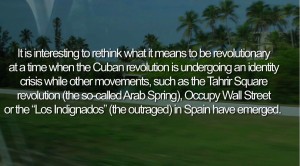
Video still, Video by Luis Martinez, 2012, copyright of Tania Bruguera, courtesy of CIFO Art Foundation.
AW: I am open to what will happen with the radio. At KW I was invited to be in that situation, I would like to work more like that…challenges that make you grow. This was about not knowing what something is yet, not having the words until you are in the situation. Also the project is stronger when it is traveling. Travel feeds the concept, provides the content. Traditionally radio is regional and not nomadic – this is online, bilingual, and nomadic. It is a different concept of “base.” The show at KW featured ways of exploring the meaning, action, and behaviors of responsibility. There were eight conversations happening, eight conversation tables, and at each table, a keynote speaker. I was thinking, “I’m going to build a platform.” For an entire month, I had coffee with curators. And the result was an entire project about conversation. The radio is the program. Really as site-specific radio, the same approach as physical site-specificity. But it was through the filter of the bilingual–and we found that you don’t need to know a language to “speak” it, to communicate. Language can be used as a tool both for inclusion and exclusion, language as survival. So the project was bringing all of this to radio. The conversation arises from the comparison of languages that are being spoken. Some of it was very literal, where the discussion of language was the content, as language experiments. It was not reportage. This is all about language, literally words. This is about listening to the words being spoken and information being communicated…the medium is speaking. And the nature of anything bilingual is that it is collaborative, and through that it also generates an interesting clash.
AS: How did this project relate to the other radio project in Berlin, for Kulturpark? This was just a bit earlier than the KW project.
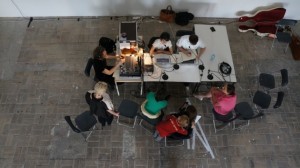
Agustina Woodgate, as part of Voicing Responsibility, KW Institute, Berlin, July 2012, image courtesy of Spinello Projects.
AW: Kulturpark was 2 years of research – each visit I would bring my audio recorder, and follow things intuitively. Sometimes I would hide it in my pocket or bag and not even let anyone know I was recording–but these were just for my own records. It was a way of hiding or subtly documenting. It was a way to get content and context together without it feeling too presented. For Kulturpark, the Miami-based collaborative
“the end/SPRING BREAK” proposed the concept of using a pirate radio platform for an exchange mechanism between Miami and Berlin.
AS: How was that experience different working with “the end/SPRING BREAK”?
AW: The focus was exchange, and site-specificity. It started mashing up music and spoken word. Patty is a music expert, and I did the spoken radio content. And then we did interviews with people about the project. Looking back, there is a strong thread in all of these radio programs. Working through language, different barriers, and there is a driving a need to communicate as a kind of social practice.
4.10.13 Conversation with Olivia Ramos and Patricia Margarita Hernandez by Amanda Sanfilippo
Amanda Sanfilippo: Where did the interest in forming an alternative university dealing with data come from? What is the lack?
Olivia Ramos: It comes from recognizing that now there is no career for what Patty does–but there should be. There is a need to find ways to form a connection between the information out there: media, data, etc., and bring it down to solve problems and have impact in communities. Bringing those high level ideas into the hands of people.
AS: And how did you become aware or interested in these problems?
OR: One thing was working with DARPA, the Defense Advance Research Projects Agency, which is the experimental hand of the department of defense. It opened my eyes to the big data problem when I did a residency with them several months ago.
Patricia Margarita Hernandez: It was a big deal, the first time they invited creatives to come in.
OR: The artists Nick Lobo, Dylan Romer, and I went up there together to Washington DC. In the end my project ended up being about feeling data with your hands and browsing data through touch. The university is going to use that as the first technology to kind of teach classes differently, and have students crawl the Internet differently.
AS: So what is your perspective on this data problem, why is there a problem or a need to experience data differently?
OR: In the last two years 90% of all the data in the world has been produced. With the technology we have today, its impossible to analyze the data in real time. It will be the same output each year, an exponential growth.
AS: What does that mean, impossible to experience it in real time?
OR: Because the data is so robust, it creates a funnel. It’s whatever the analyst can have on the screen. And there is so much that by the time you get to the bulk, its 3 years later and there is another bulk.
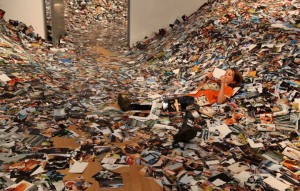
Erik Kessels, As part of the What’s Next, The Future of the Photography Museum at Foam, Amsterdam, 2011
AS: That reminds me of an installation by Erik Kessels; he printed out all of the images uploaded to Flickr in a 24-hour period to create an immense artwork filling several rooms.(I)
OR: Yes, the first project is going to be working with Twitter images that that are annotated. People post 5 to 10 pictures a day and annotate them.
AS: Annotate—meaning tag them?
OR: Yes, so for instance someone is looking for a black truck in this location at this time, and it might be in a picture somewhere. But it is really applicable in medicine. The data on cancer research available has yet to be looked at from a high level. Imagine looking at all of the data from every single hospital and being able to make connections. To zoom out enough. So right now data visualization people, their industry is growing, because if you can put it into an image it is more palpable. And that’s part of what we are going to teach is how to visualize all this information, and then automate it, and then expose the community to it.
AS: To automate?
OR: For example, you can use this if you are looking for a particular problem, such as an anomaly in a series of patterns. Every time a certain subject comes up, make a red dot. So now when you run this algorithm across a data repository, and you have seven dots, you see these seven things happen. So it is about designing the way we can read this information.
AS: Basically, when you run an algorithm, you are searching for particular kind of pattern?
OR: Yes, the simplest thing to describe it is: when this happens, make this note. If you detect this, make a note, if you don’t detect, make this note. It can get really complex. And for example one of the Deans for Particlehaus is an algorithm designer, has been designing them for 20 years. He will teach the theory of algorithms to the students.
AS: There are Deans in Particlehaus?
OR: There are two Deans. One with 30 years of experience in design theory, the other one is computer vision and design specialist. There is no totalitarian governing body. They need to check in and challenge each other to run the school.
AS: Patty, I know you have been interested in alternative education for quite some time now. How do you enter the picture here?
PMH: Through asking Olivia to come on my radio show [“Electric Lunch” on the end Radio].
AS: Is this a long term collaboration or one episode?
PMH: No, I think it is going to be long term. I’m interested in what she is doing—looking at my own work and interests there are connections. There are a couple things that stick out to me, one of which is the idea of the architect, and the different kinds of architects. Finding different ways to see things. So I found that interesting that they are opening a discussion [of new forms/structures], and referencing the Bauhaus. As the Bauhaus made their shift at that point in time, so [Particlehaus] is doing something for this particular point in time.
OR: Yes, the Bauhaus created a bunch of principles for Modernism: the ornament is crime, etc., and bared everything down. I feel like at the turn of this century, architecture is going into a virtual world, because that is where the real problems are today. Architecture is basically about problem solving, the movement of bodies, of information. It’s also a criticism on the current modes of education. The linearity of education. And we want to do a documentary, a bit of a history about how education came to be and its relationship to media is huge. Schools came to be when the newspaper came to be. So then I thought Patty would be great to lead that documentary. In both designing how we do the narrative and then being the main person on the documentary.
AS: The criticism of education is about its linearity?
OR: Yes, the linearity, that has not adjusted to all of the technology that all the kids are used to today. We are used to learning quickly at home, with TV, devices, internet, and then we get to school and we have to read this dense text which no one does, and the professor is teaching you, following the book, “This happened and then this happened.” When students go home and there is so much information at once, even in a video game. The climate, speed of car, someone’s shooting at you. They are used to using all their senses, so much stimuli. And they get to school, and its 1 + 1. So 40% of kids are on ADD medicine. We want to test different ways to intake information. Kids could be learning way faster which means they could be developing way faster. Problem-solving faster. And now we are keeping them, till 18, and don’t let them think for themselves. Then go to college and it is still regimented.
AS: Linear, like a line, as opposed to a net. A network.
OR: The Internet is a network. Before it was a newspaper, sort of linear. Now it is all over the place.
AS: So is the documentary a big project of Particlehaus, or is it a collaboration with “Electric Lunch”?
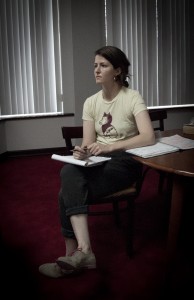
Patricia Margarita Hernandez: Electric Lunch, downtown Miami, 2013, images courtesy of the artist.
OR: It’s something that we might have to do to be able to fund the project. But it is good to have it – a way to explain where we are coming from and where we want to go. Another thing we are talking about a lot in terms of education is looking towards the future instead of looking to history, so kind of, how do you search the future, through historical data. Which is a different way of learning history (to apply it to the future).
AS: Learning history, from a future perspective?
OR: Learning the [needs of the] future, and in that process, bumping into history. The history becomes more relevant [when you need to use it, rather] than learning a line of history, and then having to go back later and apply it.
PMH: I think one of my main interests is archiving the whole thing, and seeing that there are many of these types of models, alternative education models that are relevant today. It is also nice to see it grow from this idea to what will be a university.
AS: What do you foresee the programming on “Electric Lunch” being in relation to this?
OR: Now that we have already done one radio program, for the series what would be interesting would be to sit down and think of a good outline, if there is a historical piece, maybe the history of education, and the history as it connects to media and find correlations. Then we piece-meal it on the radio, so at the end there is a big narrative, but then its also research we are interested in doing in the first place.
PMH: Segments, chapters probably. They are set to get their space in September [2013]. Once they have it, the plan is a two-story space. The first story will function as somewhat of an exhibition space, also a coffee shop will be there. From there I would come into the picture, dealing with the sound and archiving sound and being flexible to the needs of what is happening.
AS: So going there to one site and doing broadcasts.
PMH: Whether it’s a lecture I find interesting, an event, a class etc. I will be streaming it all at electriclunch.com. At the moment, I’m only committed to two days a week with “Electric Lunch” but it’s functioning about 3-4 days a week. It pops up in different places and I invite people to listen or participate, and I archive the sounds. It depends on what the event needs. It’s site-specific radio. So it depends where I am located. Now I may do a series broadcasting out of my kitchen. I’ve been thinking about where to continue taking it [after the DWNTWN Art Window project thought the Miami DDA is completed]. I am interested in conversations, negotiations, creating platforms. It’s fun to play around with at different locations. [What I am doing is] archiving sound, archiving what I consider relevant here in Miami now.
AS: How did you begin broadcasting on the radio as part of your practice?
PMH: It was born by accident. Actually, Amanda [Sanfilippo] came up to us [“the end/SPRING BREAK”] last year, and was like, “hey, lets do something with Anthony Spinello and Agustina Woodgate, this huge project called Kulturpark in Berlin [for the summer of 2012].” Originally we wanted to do a pirate radio station. They didn’t want to take the risk in Berlin to do a pirate radio, and said, why don’t you do online radio. So I went to Berlin, did the radio [in collaboration with Agustina and her radio project called “Radio Espacio Estacion (REE)”] and then continued to do projects more on my own back here in Miami.
Also, you can do whatever you want on Internet radio. It’s not regulated by the FCC. And that’s what I like, that freedom. I can be as controversial as I want or not. And there is a performative aspect, so the music that gets played on the radio is usually performed live and streamed, and I invite people not only to come and listen, but more so to come and watch [the broadcasts].
AS: Going back to the “Electric Lunch” series with Particlehaus, how does what you just described in terms of site-specific radio relate? It seems to me, the series, the process of creating content and archiving, is also formative. So it’s almost like this radio will help to develop and focus the Particlehaus ideas and use of space/programming. Which is really what a platform does in many ways.
OR: Yes and it could really be ongoing. Fine. So yes, maybe in a year Particlehaus is developed and we can use the series as an archive, of all the findings, and thinking about what that news looks like. Maybe the radio has a studio where you design news with the studio, as the curator of that studio. And as media is one of the biggest industries, this kind of education is tapping into that.
AS: In terms of alternative education structures, why do you see this collaboration necessary to happen? Particlehaus and “Electric Lunch”?
PMH: Particlehaus is filing a need for some sort of institution. Not even going into data yet, just the need for alternatives. We have Florida International University, University of Miami, St. Thomas University, and Barre University. They are falling short of a kind of intellectual development. They have different strengths. The University of Miami Medical School is awesome and progressive. The other schools have their high points, such as psychology, etc. But for intellectual growth, we need more. At least there is none that interest me. In the major cities, there’s how many alternative education schools/organizations? We don’t really have that here yet. The University of Wynwood did start doing alternative education, classes and events but it really has more to do with poetry than an art practice.(II)
I “What’s Next,” The Future of the Photography Museum at Foam, Amsterdam, 2011
II University of Wynwood is a fictitious university founded in 2008 by P. Scott Cunningham in Miami’s Little Havana neighborhood. The University’s Company Overview on their Facebook page states: “We are, first and foremost, a fake university. We have no students, no faculty, and no campus.” The organization’s main projects include O, Miami, Jai-Alai Magazine, and the UWyn Visiting Poet Series.
